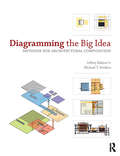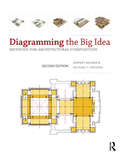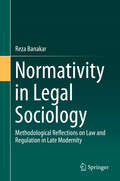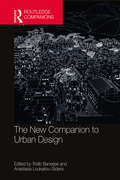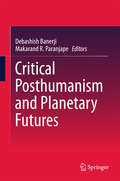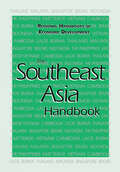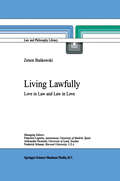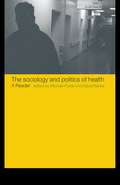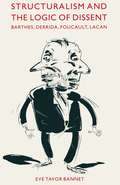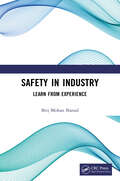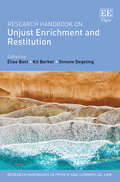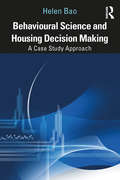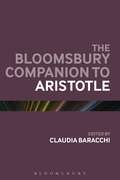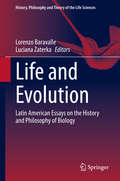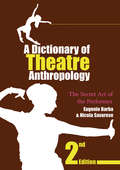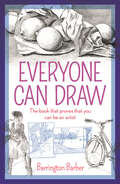- Table View
- List View
Diagramming the Big Idea: Methods for Architectural Composition
by Jeffrey Balmer Michael T. SwisherAs a beginning design student, you need to learn to think like a designer, to visualize ideas and concepts, as well as objects. In Diagramming the Big Idea, Jeffrey Balmer and Michael T. Swisher illustrate how you can create and use diagrams to clarify your understanding of both particular projects and organizing principles and ideas. With accessible, step-by-step exercises that interweave diagrams, drawings and virtual models, the authors clearly show you how to compose meaningful and useful diagrams. As you follow the development of the four project groups drawn from the authors’ teaching, you will become familiar with architectural composition concepts such as proportion, site, form, hierarchy and spatial construction. In addition, description and demonstration essays extend concepts to show you more examples of the methods used in the projects. Whether preparing for a desk critique, or any time when a fundamental insight can help to resolve a design problem, this book is your essential studio resource.
Diagramming the Big Idea: Methods for Architectural Composition
by Jeffrey Balmer Michael T. SwisherAs a beginning design student, you need to learn to think like a designer, to visualize ideas and concepts, as well as objects. In Diagramming the Big Idea, Jeffrey Balmer and Michael T. Swisher illustrate how you can create and use diagrams to clarify your understanding of both particular projects and organizing principles and ideas. With accessible, step-by-step exercises that interweave diagrams, drawings and virtual models, the authors clearly show you how to compose meaningful and useful diagrams. As you follow the development of the four project groups drawn from the authors’ teaching, you will become familiar with architectural composition concepts such as proportion, site, form, hierarchy and spatial construction. In addition, description and demonstration essays extend concepts to show you more examples of the methods used in the projects. Whether preparing for a desk critique, or any time when a fundamental insight can help to resolve a design problem, this book is your essential studio resource.
Diagramming the Big Idea: Methods for Architectural Composition
by Jeffrey Balmer Michael T. SwisherBecoming an architect is a daunting task. Beyond the acquisition of new skills and procedures, beginning designers face an entirely unfamiliar mode of knowledge: design thinking. In Diagramming the Big Idea, Jeffrey Balmer and Michael T. Swisher introduce the fundamentals of design thinking by illustrating how architects make and use diagrams to clarify their understanding of both specific architectural projects and universal principles of form and order. With accessible, step-by-step procedures that interweave diagrams, drawings and virtual models, the authors demonstrate how to compose clear and revealing diagrams. Design thinking defines a method for engaging the world through observation and analysis. Beyond problem solving, design is a search for possibilities. Mastering design thinking begins with learning the fundamentals of visual composition. It embraces the ability to synthesize deductive and imaginative reasoning, combining both shrewd scrutiny and fevered speculation. Design diagrams make visible the abstractions that order the built environment. Premised upon the Beaux-Arts notion of the architectural parti, Balmer and Swisher adopt the ‘Big Idea’ as a foil and as a suitcase to organize fundamentals of architectural composition. The goal of this book is to make explicit to students what they are learning, why they are learning it and how to internalize such lessons toward their lifelong development as designers.
Diagramming the Big Idea: Methods for Architectural Composition
by Jeffrey Balmer Michael T. SwisherBecoming an architect is a daunting task. Beyond the acquisition of new skills and procedures, beginning designers face an entirely unfamiliar mode of knowledge: design thinking. In Diagramming the Big Idea, Jeffrey Balmer and Michael T. Swisher introduce the fundamentals of design thinking by illustrating how architects make and use diagrams to clarify their understanding of both specific architectural projects and universal principles of form and order. With accessible, step-by-step procedures that interweave diagrams, drawings and virtual models, the authors demonstrate how to compose clear and revealing diagrams. Design thinking defines a method for engaging the world through observation and analysis. Beyond problem solving, design is a search for possibilities. Mastering design thinking begins with learning the fundamentals of visual composition. It embraces the ability to synthesize deductive and imaginative reasoning, combining both shrewd scrutiny and fevered speculation. Design diagrams make visible the abstractions that order the built environment. Premised upon the Beaux-Arts notion of the architectural parti, Balmer and Swisher adopt the ‘Big Idea’ as a foil and as a suitcase to organize fundamentals of architectural composition. The goal of this book is to make explicit to students what they are learning, why they are learning it and how to internalize such lessons toward their lifelong development as designers.
Normativity in Legal Sociology: Methodological Reflections on Law and Regulation in Late Modernity
by Reza BanakarThe field of socio-legal research has encountered three fundamental challenges over the last three decades – it has been criticized for paying insufficient attention to legal doctrine, for failing to develop a sound theoretical foundation and for not keeping pace with the effects of the increasing globalization and internationalization of law, state and society. This book examines these three challenges from a methodological standpoint. It addresses the first two by demonstrating that legal sociology has much to say about justice as a kind of social experience and has always engaged theoretically with forms of normativity, albeit on its own empirical terms rather than on legal theory’s analytical terms. The book then explores the third challenge, a result of the changing nature of society, by highlighting the move from the industrial relations of early modernity to the post-industrial conditions of late modernity, an age dominated by information technology. It poses the question whether socio-legal research has sufficiently reassessed its own theoretical premises regarding the relationship between law, state and society, so as to grasp the new social and cultural forms of organization specific to the twenty-first century’s global societies.
The New Companion to Urban Design
by Tridib Banerjee Anastasia Loukaitou-SiderisThe New Companion to Urban Design continues the assemblage of rich and critical ideas about urban form and design that began with the Companion to Urban Design (Routledge, 2011). With chapters from a new set of contributors, this sequel offers a more comparative perspective representing multiple voices and perspectives from the Global South. The essays in this volume are organized in three parts: Part I: Comparative Urbanism; Part II: Challenges; and Part III: Opportunities. Each part contains distinct sections designed to address specific themes, and includes a list of annotated suggested further readings at the end of each chapter. Part I: Comparative Urbanism examines different variants of urbanism in the Global North and the Global South, produced by a new economic order characterized by the mobility of labor, capital, information, and technology. Part II: Challenges discusses some of the contemporary challenges that cities of the Global North and the Global South are facing and the possible role of urban design. This part discusses spatial claims and conflicts, challenges generated by urban informality, explosive growth or dramatic shrinkage of the urban settlement, gentrification and displacement, and mimesis, simulacra and lack of authenticity. Part III: Aspirations discusses some normative goals that urban design interventions aspire to bring about in cities of the Global North and the Global South. These include resilience and sustainability, health, conservation/restoration, justice, intelligence, access and mobility, and arts and culture. The New Companion to Urban Design is primarily intended for scholars and graduate students interested in cities and their built environment. It offers an invaluable and up-to-date guide to current thinking across a range of disciplines including urban design, planning, urban studies, and geography.
The New Companion to Urban Design
by Tridib Banerjee Anastasia Loukaitou-SiderisThe New Companion to Urban Design continues the assemblage of rich and critical ideas about urban form and design that began with the Companion to Urban Design (Routledge, 2011). With chapters from a new set of contributors, this sequel offers a more comparative perspective representing multiple voices and perspectives from the Global South. The essays in this volume are organized in three parts: Part I: Comparative Urbanism; Part II: Challenges; and Part III: Opportunities. Each part contains distinct sections designed to address specific themes, and includes a list of annotated suggested further readings at the end of each chapter. Part I: Comparative Urbanism examines different variants of urbanism in the Global North and the Global South, produced by a new economic order characterized by the mobility of labor, capital, information, and technology. Part II: Challenges discusses some of the contemporary challenges that cities of the Global North and the Global South are facing and the possible role of urban design. This part discusses spatial claims and conflicts, challenges generated by urban informality, explosive growth or dramatic shrinkage of the urban settlement, gentrification and displacement, and mimesis, simulacra and lack of authenticity. Part III: Aspirations discusses some normative goals that urban design interventions aspire to bring about in cities of the Global North and the Global South. These include resilience and sustainability, health, conservation/restoration, justice, intelligence, access and mobility, and arts and culture. The New Companion to Urban Design is primarily intended for scholars and graduate students interested in cities and their built environment. It offers an invaluable and up-to-date guide to current thinking across a range of disciplines including urban design, planning, urban studies, and geography.
Critical Posthumanism and Planetary Futures
by Debashish Banerji Makarand R. ParanjapeThis volume is a critical exploration of multiple posthuman possibilities in the 21st century and beyond. Due to the global engagement with advanced technology, we are witness to a species-wise blurring of boundaries at the edge of the human. On the one hand, we find ourselves in a digital age in which human identity is being transformed through networked technological intervention, a large part of our consciousness transferred to "smart" external devices. On the other hand, we are assisted---or assailed---by an unprecedented proliferation of quasi-human substitutes and surrogates, forming a spectrum of humanoids with fuzzy borders. Under these conditions, critical posthumanism asks, who will occupy and control our planet: Will the "superhuman" merely serve as another sign under which new regimes of dominance are spread across the earth? Or can we discover or invent technologies of existence to counter such dominance? It is issues such as these which are at the heart of this new volume of explorations of the posthuman. The essays in this volume offer leading-edge thought on the subject, with special emphases on postmodern and postcolonial futures. They engage with questions of subalternity and feminism vis-à-vis posthumanism, dealing with issues of subjugation, dispensability and surrogacy, as well as the possibilities of resistance, ethical politics or subjective transformation from South Asian archives of cultural and spiritual practice. This volume is a valuable addition to the on-going global dialogues on posthumanism, indispensable to those, from across several disciplines, who are interested in postcolonial and planetary futures.
The Southeast Asia Handbook (Regional Handbooks of Economic Development #Vol. 3)
by Greg Bankoff Michael Haas Patrick Heenan Monique LamontagneThe Regional Handbooks of Economic Development series provides accessible overviews of countries within their larger domestic and international contexts, focusing on the relations among regions as they meet the challenges of the twenty first century.The series allows the non-specialist student to explore a wide range of complex factors-social and political as well as economic-that affect the growth of developing regions in Asia, Europe, and South America. Each Handbook provides an overview chapter discussing the region's economic conditions within an historical and political context, as well as 20 or more chapter-length essays written by recognized experts, which analyze the key issues affecting a region's economy: its population, natural resources, foreign trade, labor problems, and economic inequalities, and other vital factors.In addition, the volumes offer useful support materials, including a series of appendices that include a detailed chronology of events in the region, a glossary of terms, biographical entries on key personalities, an annotated bibliography of further reading, and a comprehensive analytical index.
Living Lawfully: Love in Law and Law in Love (Law and Philosophy Library #53)
by Z. BankowskiThe aim of this book is to explore what it means to live a life under the law. Does a life of law preclude love and does a life of love preclude law? Part of the theme of the book is that social questions also raise individual moral and ethical questions; that to live lawfully implies both a question of how I should live in my relations with my fellows and how society should be organised. These questions must be looked at together. The book explores these questions and in looking at the articulation of law and love touches upon debates in personal morality, aesthetics, epistemology, social and political organisation, institutional design and the form and substance of law. It raises questions that are of interest to students and those working in law, theology, and social and political theory.
The Sociology and Politics of Health: A Reader
by David Banks Michael PurdyHealth care systems, the role of health professionals and the experience of health and illness are all undergoing change and development as we enter the twenty-first century. The Sociology and Politics of Health is a collection of key readings through which to explore the sociological and political dimensions of health, illness and health care. Combining classic pieces with more up-to-date contributions, it includes examples taken from current domestic and international initiatives and draws on humanist, materialist, feminist and constructionalist perspectives. The Sociology and Politics of Health covers: * ideology and policy * social stratification * professionalisation * the experience of health and illness. * This reader offers health studies students, nurses and other health professionals an invaluable introduction to an increasingly important field of social inquiry.
The Sociology and Politics of Health: A Reader
by David Banks Michael PurdyHealth care systems, the role of health professionals and the experience of health and illness are all undergoing change and development as we enter the twenty-first century. The Sociology and Politics of Health is a collection of key readings through which to explore the sociological and political dimensions of health, illness and health care. Combining classic pieces with more up-to-date contributions, it includes examples taken from current domestic and international initiatives and draws on humanist, materialist, feminist and constructionalist perspectives. The Sociology and Politics of Health covers: * ideology and policy * social stratification * professionalisation * the experience of health and illness. * This reader offers health studies students, nurses and other health professionals an invaluable introduction to an increasingly important field of social inquiry.
Structuralism and the Logic of Dissent: Barthes, Derrida, Foucault, Lacan
by Eve Tavor BannetStructuralism and the Logic of Dissent is a fascinating and lucid exploration of the seminal writings of four eminent French structuralists that sheds new light on influential theoretical texts. Eve Tavor Bannet discusses the work of Barthes, Derrida, Foucault, and Lacan as coherent philosophical fictions, showing their contradictory political, social, and pedagogical implications and their complex historicity.
Safety in Industry: Learn from Experience
by Brij Mohan BansalThis concise book presents years of the author’s practical experiences on industrial safety through various case studies. It aims to quip professionals in their respective industrial fields with different safety management systems, like the knowledge of common dos and don’ts, Standard Operating Procedures (SOP), and even the Emergency handling and use of PPEs. Print edition not for sale in South Asia (Bangladesh, Bhutan, India, Nepal, Pakistan and Sri Lanka)
Safety in Industry: Learn from Experience
by Brij Mohan BansalThis concise book presents years of the author’s practical experiences on industrial safety through various case studies. It aims to quip professionals in their respective industrial fields with different safety management systems, like the knowledge of common dos and don’ts, Standard Operating Procedures (SOP), and even the Emergency handling and use of PPEs. Print edition not for sale in South Asia (Bangladesh, Bhutan, India, Nepal, Pakistan and Sri Lanka)
Research Handbook on Unjust Enrichment and Restitution (Research Handbooks in Private and Commercial Law series)
by Elise Bant Kit Barker Simone DegelingThis comprehensive yet accessible Research Handbook offers an expert guide to the key concepts, principles and debates in the modern law of unjust enrichment and restitution. Written by leading experts drawn from a wide range of common law, civilian and mixed jurisdictions, chapters cover the complex history, scope and philosophical foundations of the subject, its organisational structure, main liability principles, defences and remedies. Utilising a broad array of legal authority and academic commentary, contributors engage with the key concepts and debates in a way that offers a direct route into the field for new researchers, as well as a source of original thinking for those already familiar with the subject. Throughout, the learning of both civilian and common law legal systems is juxtaposed and integrated, offering useful comparative insights and lessons for the future development of this still young, but critically important field of law. Engaging and thought provoking, the Research Handbook on Unjust Enrichment and Restitution will prove indispensable to academics and researchers in the field of private and commercial law. Judges and practitioners will also have much to gain from the clear presentation of authorities, principles and useful comparative perspectives.
Behavioural Science and Housing Decision Making: A Case Study Approach
by Helen BaoThis book takes a behavioural approach to examine six important housing questions: tenure decision, gentrification, place attachment, housing bubbles, housing wealth, and residential satisfaction. Using experimental and field data, the book demonstrates the effects of six behavioural biases and heuristics (i.e., anchoring and reference dependence, loss aversion, mental accounting, endowment effect, herd behaviours, and social comparison) on these housing decisions. The first part of the book introduces the questions and provides a behavioural science toolbox before the second part adopts a real-world case study approach. Real data sets and suggested answers are provided, and the cases come from the UK, USA, and China. Background information is given in each case to facilitate the understanding of the case data and question, as well as the discussions on the results. This book is ideal supplementary reading on a variety of courses such as housing studies, economics, real estate, research methods, and for students and academics who are interested in the application of behavioural science in housing decisions.
Behavioural Science and Housing Decision Making: A Case Study Approach
by Helen BaoThis book takes a behavioural approach to examine six important housing questions: tenure decision, gentrification, place attachment, housing bubbles, housing wealth, and residential satisfaction. Using experimental and field data, the book demonstrates the effects of six behavioural biases and heuristics (i.e., anchoring and reference dependence, loss aversion, mental accounting, endowment effect, herd behaviours, and social comparison) on these housing decisions. The first part of the book introduces the questions and provides a behavioural science toolbox before the second part adopts a real-world case study approach. Real data sets and suggested answers are provided, and the cases come from the UK, USA, and China. Background information is given in each case to facilitate the understanding of the case data and question, as well as the discussions on the results. This book is ideal supplementary reading on a variety of courses such as housing studies, economics, real estate, research methods, and for students and academics who are interested in the application of behavioural science in housing decisions.
The Bloomsbury Companion to Aristotle (Bloomsbury Companions)
by Claudia BaracchiAristotle is one of the most crucial figures in the history of Western thought, and his name and ideas continue to be invoked in a wide range of contemporary philosophical discussions. The Bloomsbury Companion to Aristotle brings together leading scholars from across the world and from a variety of philosophical traditions to survey the recent research on Aristotle's thought and its contributions to the full spectrum of philosophical enquiry, from logic to the natural sciences and psychology, from metaphysics to ethics, politics, and aesthetics. Further essays address aspects of the transmission, preservation, and elaboration of Aristotle's thought in subsequent phases of the history of philosophy (from the Judeo-Arabic reception to debates in Europe and North America), and look forward to potential future directions for the study of his thought.In addition, The Bloomsbury Companion to Aristotle includes an extensive range of essential reference tools offering assistance to researchers working in the field, including a chronology of recent research, a glossary of key Aristotelian terms with Latin concordances and textual references, and a guide to further reading.
The Bloomsbury Companion to Aristotle (Bloomsbury Companions)
by Claudia BaracchiAristotle is one of the most crucial figures in the history of Western thought, and his name and ideas continue to be invoked in a wide range of contemporary philosophical discussions. The Bloomsbury Companion to Aristotle brings together leading scholars from across the world and from a variety of philosophical traditions to survey the recent research on Aristotle's thought and its contributions to the full spectrum of philosophical enquiry, from logic to the natural sciences and psychology, from metaphysics to ethics, politics, and aesthetics. Further essays address aspects of the transmission, preservation, and elaboration of Aristotle's thought in subsequent phases of the history of philosophy (from the Judeo-Arabic reception to debates in Europe and North America), and look forward to potential future directions for the study of his thought.In addition, The Bloomsbury Companion to Aristotle includes an extensive range of essential reference tools offering assistance to researchers working in the field, including a chronology of recent research, a glossary of key Aristotelian terms with Latin concordances and textual references, and a guide to further reading.
Life and Evolution: Latin American Essays on the History and Philosophy of Biology (History, Philosophy and Theory of the Life Sciences #26)
by Lorenzo Baravalle Luciana ZaterkaThis book offers to the international reader a collection of original articles of some of the most skillful historians and philosophers of biology currently working in Latin American universities. During the last decades, increasing attention has been paid in Latin America to the history and philosophy of biology, but since many local authors prefer to write in Spanish or in Portuguese, their ideas have barely crossed the boundaries of the continent. This volume aims to remedy this state of things, providing a good sample of this production to the English speaking readers, bringing together contributions from researchers working in Brazilian, Argentinean, Chilean, Colombian and Mexican universities. The stress on the regional provenance of the authors is not intended to suggest the existence of something like a Latin American history and philosophy of biology, supposedly endowed with distinctive features. On the contrary, the editors firmly believe that advances in this field can be achieved only by stimulating the integration in the international debate. Based on this assumption, the book focuses on two topics, life and evolution, and presents a selection of contributions addressing issues such as the history of the concept of life, the philosophical reflection on life manipulation and life extension, the structure and development of evolutionary theory as well as human evolution. Life and Evolution – Latin American Essays on the History and Philosophy of Biology will provide the international reader with a rather complete picture of the ongoing research in the history and philosophy of biology in Latin America, offering a snapshot of this dynamic community. It will also contribute to contextualize and develop the debate concerning life and evolution, and the relation between the two phenomena.
A Dictionary of Theatre Anthropology: The Secret Art of the Performer
by Eugenio Barba Nicola SavareseFirst Published in 2005. A Dictionary of Theatre Anthropology subtly juxtaposes visual demonstrations of the performer’s craft, from a wealth of Eastern and Western sources. More than just a dictionary, this is a handbook for theatre practitioners and a guide for students and scholars of transcultural performance. It is the result of many years of research conducted by Eugenio Barba and the International School of Theatre Anthropology (ISTA) based in Denmark, and is now a classic foundational text. Whereas most Western research is concerned with naturalism and psychological realism in acting, the Dictionary focuses on the actor’s arduous and eclectic craft. The Dictionary aims to expand our knowledge of the possibilities of the scenic body, and of the spectator’s response to the dynamics of performance. The Dictionary has practical sections on balance, opposition and montage among other techniques, and discusses issues including The Text and the Stage, The Dilated Body and Energetic Language. This revised edition includes: three new chapters on Eurasian Theatre, Exercises and Organicity; 50 new photographs showing the performer’s craft in black and white and colour; and, for the first time, a useful bibliography and index.
A Dictionary of Theatre Anthropology: The Secret Art of the Performer
by Eugenio Barba Nicola SavareseFirst Published in 2005. A Dictionary of Theatre Anthropology subtly juxtaposes visual demonstrations of the performer’s craft, from a wealth of Eastern and Western sources. More than just a dictionary, this is a handbook for theatre practitioners and a guide for students and scholars of transcultural performance. It is the result of many years of research conducted by Eugenio Barba and the International School of Theatre Anthropology (ISTA) based in Denmark, and is now a classic foundational text. Whereas most Western research is concerned with naturalism and psychological realism in acting, the Dictionary focuses on the actor’s arduous and eclectic craft. The Dictionary aims to expand our knowledge of the possibilities of the scenic body, and of the spectator’s response to the dynamics of performance. The Dictionary has practical sections on balance, opposition and montage among other techniques, and discusses issues including The Text and the Stage, The Dilated Body and Energetic Language. This revised edition includes: three new chapters on Eurasian Theatre, Exercises and Organicity; 50 new photographs showing the performer’s craft in black and white and colour; and, for the first time, a useful bibliography and index.
Everyone Can Draw
by Barrington BarberBarrington Barber takes as his starting point the belief that everyone - whatever their experience - can learn to draw well.In this book, after introducing different drawing materials and mark making, he goes on to show how line, tone and proportion can be used to create convincing, realistic drawings. Exercises are set out in easy steps so the drawing process is clear for all to follow.Tuition in essential drawing techniques is accompanied by explanations of practical processes such as copying, tracing and measuring, as well as how to use photographs as the basis of drawing.Fresh and accessible, this book will appeal to those who are interested in learning to draw, or who wish to hone their existing skills in this most dynamic and rewarding of activities.
